"Windjammer" Telecine |
Read more
at in70mm.com The 70mm Newsletter |
| Written by: David Strohmaier | Date: 01.12.2009 |
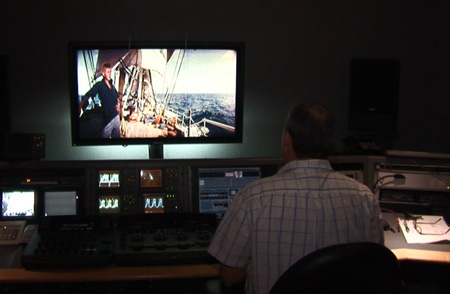 Telecine 1. Telecine operator Scott Maloney adjusting the anamorphic image from the 35mm
composite into the 16 x 9 format to get maximum pixel information on the
screen. Telecine was done at ModernVideo Film right across the street from
Warner Brothers Studio in Burbank. Telecine 1. Telecine operator Scott Maloney adjusting the anamorphic image from the 35mm
composite into the 16 x 9 format to get maximum pixel information on the
screen. Telecine was done at ModernVideo Film right across the street from
Warner Brothers Studio in Burbank.By October 2009 we finished the telecine of the 3 panel composite Swedish Film Institute print and it looks like we got 85 percent of the color back in on the first pass, next pass will be scene to scene color correction and dirt fixes. Here is a first look (Quicktime needed) at some scenes from "Widjammer". This is a first pass and does not have final color correction, final sound SounDesign 7.1 mix, final SmileBox tweaks/adjustments or any panel alignments. |
More
in 70mm reading: "Windjammer" Press Release Internet link: |
.jpg) Telecine 4. Scope settings for contrast on "Windjammer" Telecine 4. Scope settings for contrast on "Windjammer"One thing we discovered is at the beginning of the 3 panel section there is a fade in on the ship. Since we want to be accurate for our roadshow version I was wondering if at any of the original roadshow showings the "change over" from the end of the prologue (which has no fade) to the 3 panel was supposed to be a direct or "smash" cut or did the first 3 panel shot fade in after the prologue cuts out. In other words was there any black between or did it straight cut to the 3 panel ship at sea without the fade up as the curtains opened. I always thought it was just a cut to 3 panel so the fade seems a bit strange. Also there were about 5 to 6 other areas where the film has a fade out from a scene but a straight cut in (no fade in) so we were wondering if we should add a fade in at those points or just leave it as we found it. |
|
 Philip-1 Philip-1Philip Hodgetts of Intelligent Assistance monitors the scopes during the telecine. Intelligent Assistance is the "Windjammer" HD project consultants. Francois CARRIN, France remembers the French version of "Windjammer" "The French editing was noticeably different. French version starts with an impressive musical overture about 2 or 3 minutes, played with the seven channels magnetic system (Of course, during overture and titles A, B & C were running with leaders on reels). Then auditorium lights fade out and titles - golden letters on dark blue background - are screened from a 35mm academy print... on the closed curtain!, and it was very legible. 35mm academy projector (a Simplex) was installed on the left of Baker. Then, at the end of titles music seems more light and quiet and suddenly the 3 panels system opens on the full screen. There is no fade out for titles and no fade in for 3 panels. The first 3 panels sequence is the contre-jour shot on sails of the ship with the ringing bell - about 5 minutes in the original editing - In the same time curtain opens. It's long to explain this but in fact the effect lasts for 2 or 3 seconds !!! For my personal opinion the suddenly transition between titles and film is very impressive. |
|
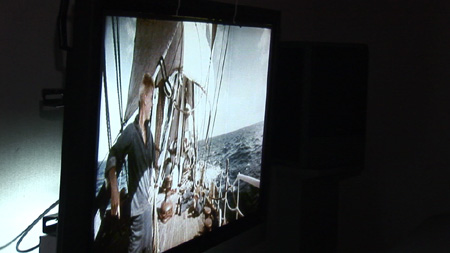 Telecine 2.
Another angle of the telecine monitor as preliminary color work starts in
the telecine session. Critical color work and any color work between panels
will be done later. Telecine 2.
Another angle of the telecine monitor as preliminary color work starts in
the telecine session. Critical color work and any color work between panels
will be done later.I hope to have "Windjammer" done by mid February or early March 2010. After restoration we will gather supplemental stuff for the eventual DVD "extras". Using some new software called "Furnace" I think it was developed in the UK. |
|
 Telecine 3 Telecine 3Scott threads up another reel of the Swedish Film Institutes rare composite 35mm print. |
|
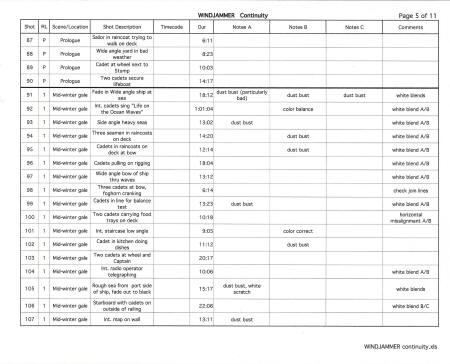 After telecine is finished a detailed continuity of each shot in the film is
created. This is where we plot out what needs to be done to clean up each
particular scene and in some cases each panel. Notes A, B, & C is for Able,
Baker and Charlie panels. After telecine is finished a detailed continuity of each shot in the film is
created. This is where we plot out what needs to be done to clean up each
particular scene and in some cases each panel. Notes A, B, & C is for Able,
Baker and Charlie panels.Click the image to see enlargement |
|
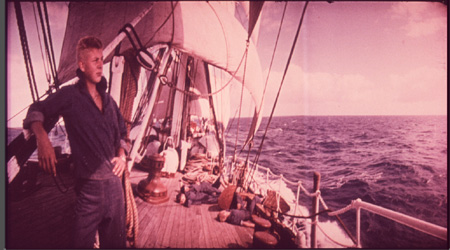 Before
color work-1 Before
color work-1Image is squeezed into 16 x 9 at telecine this is the image before any color work begins. |
|
 Early
color tests Letterbox-2 Early
color tests Letterbox-2Now we do some further refined color correction in Dave’s computer using Apples’ Final Cut Pro Color system. Click image to see enlargement |
|
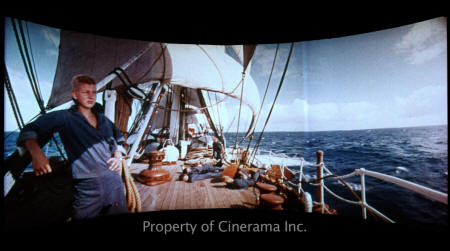 Early
color tests Smilebox-3 Early
color tests Smilebox-3SmileBox version of the above Click image to see enlargement |
|
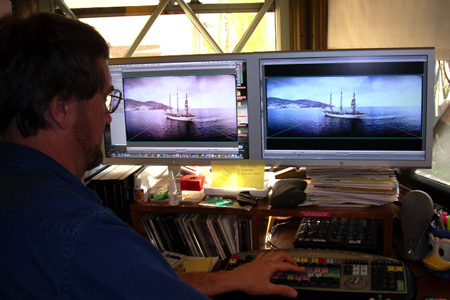 Color
Pink to blue-1 Color
Pink to blue-1Dave does some color work –notice the original faded mage on the left |
|
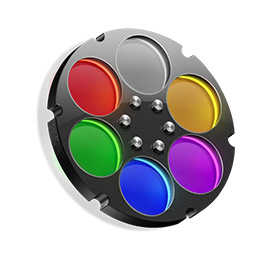 Apple’s
Color Logo Apple’s
Color LogoFor final color correction and color correction between panels we will be using Apple’s Final Cut Pro studio color software. |
|
 Furnace
Logo Furnace
LogoWe are using a special software program called “Furnace” for dust busting and scratch removal. It was created by The Foundry a visual effects software company located in London. |
|
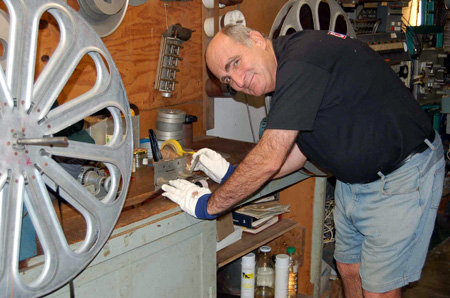 Cutting
Intermission clips-1 Cutting
Intermission clips-1The Swedish print contained no intermission strip, so in order to create a road show version in HD David Coles of Australia cut some frames out of John Mitchell’s 3-strip print so an intermission title can be created in Texas by Martin Hart. This project is truly becoming an international effort. |
|
 Winjammer
A Winjammer
AThe A panel clip from John Mitchell’s print. |
|
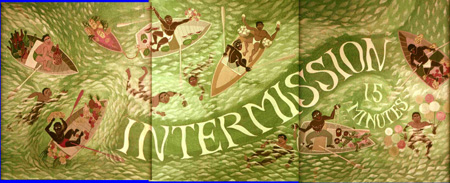 Intermission
before-1 Intermission
before-1Very early color work on the strips |
|
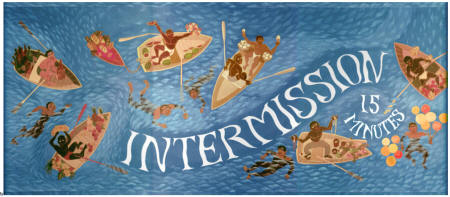 Intermission
After-1. Click image to see enlargement Intermission
After-1. Click image to see enlargementThe result after Martin Hart (American Widescreen Museum) finishes his re creation of the original Windjammer intermission title. |
|
 Panel
Alignment check-1 Panel
Alignment check-1Dave is working on ways to improve the panel joins. Each panel can be only be adjusted slightly. Since the print was a composite (all three panels in one frame) there is little latitude to create the type of panel blends that was done on the remastering of "How The West Was Won". |
|
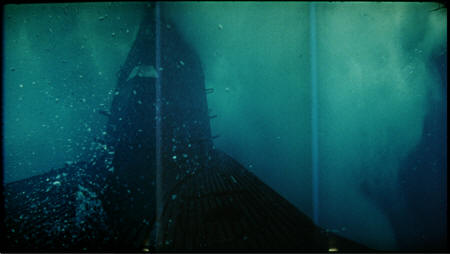 Cc
Able 2.
Click image to see enlargement Cc
Able 2.
Click image to see enlargementBefore work begins on white panel blend lines |
|
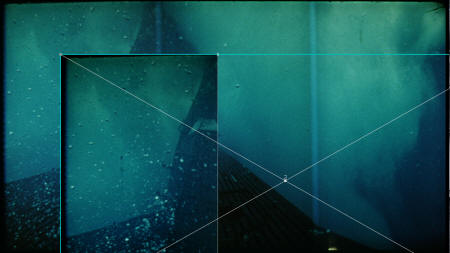 Cc
Able 3 Cc
Able 3Edges are softened a bit on able to re blend them to help minimize the whiteish panel joins. Click image to see enlargement |
|
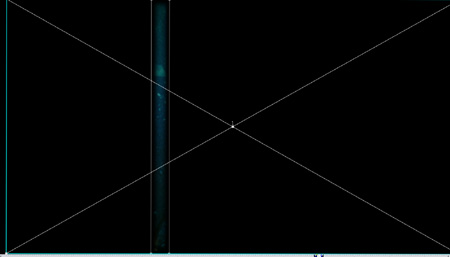 A, B
Panel Blend helper A, B
Panel Blend helperAn overlay sample called a “panel helper” is created for between A panel and B panel |
|
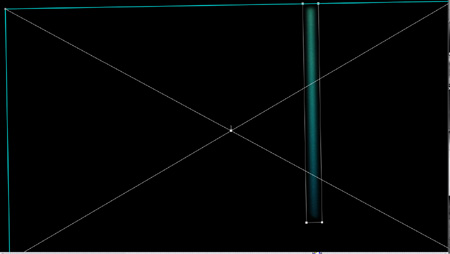 B, C
Panel blend helper B, C
Panel blend helperAnother one for between B and C panels. |
|
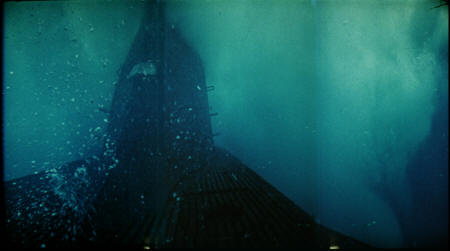 Panel
Blend with helpers on Panel
Blend with helpers onHere the “panel helpers” are applied to the frame. Several scenes in the film will need to have this difficult animated blend helper process done while many others will not. Click image to see enlargement |
|
 From
a test of the 3-strip material done in October 2008 by Greg Kimble.
Click to see enlargement. From
a test of the 3-strip material done in October 2008 by Greg Kimble.
Click to see enlargement.Thought you'd like to be the first to see a single frame test of Windjammer. I had a terrible time with it, and I think it can be better. The negative is very badly faded, and the scan was quite dark. That accounts for the quantizing in the faces and uniforms and the high noise level. I've spoken to the scanner people about some custom settings that might give me a better scan to start with, which would mean more usable data to correct. Greg Kimble |
|
|
Go: back
- top - back issues
- news index Updated 22-01-25 |
|
